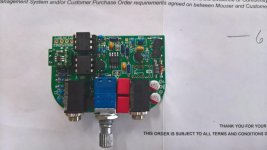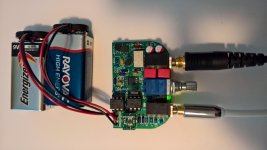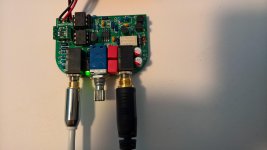Copper foil instead of tin foil?
Actually is gold!
Last edited:
WesionTEK Khadas "Tone Board" successfully integrated with agdr Audio Super CMoy.
Congratulations! Very nice.
I currently use a Mini3, but keep blowing opamps because of the virtual ground whereas the Super CMOY has "real" ground.
Apologies for not seeing this post sooner, I've been off the forum a while due to just being really busy.
He wrote that up comparing his real-ground O2 headphone amp (and of course the Super CMOY headamp here has a real ground) vs. the virtual-ground mini3.
Last edited:
Hey AGDR!!
Nice work on the build!
I do have the relays - email sent. onlinecomponents.com has them too right now:
IM26TS relay in stock
...also goes by 3-1462039-2
It is the same relay used on the O2 Booster Board. But that would be another shipping charge just for the relay, from onlinecomponents. Might was well get it with the PC board if someone is getting a PC board. Onlinecomponents is where I bought mine, a lot of 50 I think it was. They are an authorized distributor, btw, just like Mouser and Digikey.
One tricky thing about this IM26TS relay - it also goes by the number 3-1462039-2 ! Same part. TE connectivity did that a couple of year ago, just to make things confusing I guess.
Last edited:
Alex, you inbox seems to be full, been trying to answer you. Just want to say thank you to both adydula and agdr for fixing the problem with the out of stock delay relay!
Saw now that i missed the picture of the build, looks real nice! Cant wait to listen to it!
Saw now that i missed the picture of the build, looks real nice! Cant wait to listen to it!
Last edited:
Those prebuilt TPS boards sure do make it easier!!
Agreed! The TPS3701 chip is just crazy small for DIY work, as is the associated capacitor. Ha first time I tried to solder one myself I gave up after the first minute, and I've been soldering for nearly 50 years. I very quickly decided "nope, gotta make this thing bigger somehow for it to be DIY-friendly".
Edit! Hi Oscar, we posted at the same time.
Last edited:
New BOM posted at the project Google Drive link
I've just posted a new version of the BOM, V14, at the project Google Drive link (in the first post in this thread).
A few things...
* I added words about the two part numbers for the same relay, as mentioned above in post #385. Was already in there sort-of, since Mouser uses the IM26TS number while Digikey uses the 3-1462039-2 number. The words should help explain and clarify. But regardless both are out of stock and show that uber-long wait time for stock. As mentioned above onlinecomponents.com has them and so do I.
* I've decided on a new capacitor for C10. Please disregard the TDK part (the 810-FA22X7R...) I mentioned above in post #380. It is pricier and much larger than the original. I've specified a Murata part now, 81-RCER71E335K2M1H3A at Mouser.
I've just gone through all the parts at Mouser and Digikey to update prices on the BOM and check stock, *except* all those gain resistor options in yellow highlighting. Don't have time for those right now. If you spot one out of stock please let me know. In general everything is in stock at Mouser right now except the relay.
Don't have time for those right now. If you spot one out of stock please let me know. In general everything is in stock at Mouser right now except the relay.
I've just posted a new version of the BOM, V14, at the project Google Drive link (in the first post in this thread).
A few things...
* I added words about the two part numbers for the same relay, as mentioned above in post #385. Was already in there sort-of, since Mouser uses the IM26TS number while Digikey uses the 3-1462039-2 number. The words should help explain and clarify. But regardless both are out of stock and show that uber-long wait time for stock. As mentioned above onlinecomponents.com has them and so do I.
* I've decided on a new capacitor for C10. Please disregard the TDK part (the 810-FA22X7R...) I mentioned above in post #380. It is pricier and much larger than the original. I've specified a Murata part now, 81-RCER71E335K2M1H3A at Mouser.
I've just gone through all the parts at Mouser and Digikey to update prices on the BOM and check stock, *except* all those gain resistor options in yellow highlighting.
Last edited:
As soon as I get the relay I will install and test!!
Should be there Thursday, USPS tells me.
I drive 16ohm ZS6’s no problem. But these are 114dB sensitive so not much needed to be dangerous to your ear’s health. 
Is this CMOY amp good enough ?
Is this CMOY amp good enough ?
Wondering why the input RC low pass filter of the CMOY of 274 ohms with 220 pF of 2.6 MHz is set so high?
Good question! They are the same values that NwAvGuy used for the input RF filter on his O2 headamp:
O2 headamp details see the "documentation package" link on the second page (scroll down) for the schematic.
I wanted to keep the design close to the O2. I think that I asked him once in PM about why that filter corner frequency was so high. Can't quite remember the answer now. Part of it might have been the corner is the 3dB point, high keeps more of the filter out of the audio band, especially if designing to pass 20kHz square waves, which takes the needed response up to at least 5x (100Khz) for the Fourier components, ideally 10x (200KHz).
Last edited:
Would your amp work with 32Ohm impedance earphones ?
Yes, we've been PM chatting on this one and I wanted to post for anyone else out there who may be interested. A few things..
Remember that it isn't just the impedance but also the headphone or IEM sensitivity that determines drive requirements. They work together. Low Z (impedance) with high sensitivity isn't hard to drive, which is the case with a lot of modern cans designed to work with cellphones and such. The same low Z with very low sensitivity (usually decades-old headphones) are harder to drive.
On sensitivity, be careful about the units, too! Older headphones and IEMs - and even some modern ones - use dB/mW. Never cans use dB/V. Makes a sizable difference in the calculations. In the SPL spreadsheet (more below), put a "0" for the one you are not using. For example, if you have 116dB/V sensitivity IEMs, put a zero (number, not letter, of course) in the input field for "per mW," then enter your 116 in the field for "per volt"
And finally, knowing all this ^^^^ you can plug the impedance and sensitivity into the headphone Sound Pressure Level spreadsheet here at the projects' Google Drive link (you might already find your headphone in the list):
headphone and IEM SPL spreadsheet
From that spreadsheet you can read off the RMS voltage and RMS current that a headphone amp would need to hit 90 dB SPL and 110dB SPL. (3rd box down, the "voltage required" and "current required" output fields WHICH ARE IN RMS) 110dB SPL is as loud as a freight train going by, intended to be the level of very short duration musical peaks (which, btw, can easily be 10x or 20x the average music loudness level, especially in classical music). Arguably you don't need more than 110dB (some do design for 120 dB).
You will find that the single chip SuperCMOY provides (often more than) enough RMS voltage and current for probably 80% of the headphones and IEMs out there. It is a rare one that would require the dual-chip SuperCMOY for more current drive, or some other headphone amplifier to provide more voltage drive. Usually those are older models.
So long story short, the SuperCMOY can power 16 ohm headphones and IEMs at low THD thanks to the OPA1688 chip, like xrk971 said. But the sensitivity will determine single or dual chip, or other headamp for more voltage drive.
* note on RMS values. The maximum amount of voltage or current (75mA maximum) per channel the Super CMOY can put out are PEAK values. To convert peak to RMS (in the case of sine waves anyway, which is audio) multiply by 0.707 (or divide by 1.414). For example, the maximum/peak current per channel of the OPA1688 is 75mA. 75mA * 0.707 = 53mA RMS. And I think I've said elsewhere if you find your requirements are even getting close to that, like say 48 mA RMS, then go to the dual chip SuperCMOY for 2x the current capability. There are small "penalties" in using the dual chip version, like double the (still extremely low) DC output offset voltage. Use the single chip if you can, based on what the SPL spreadsheet shows you need.
Last edited:
Oscar,
The relay arrived today and I am listening with your Super Cmoy right now. Its driving my Beyer T1's and T90's very well...amp is great. Dead quiet...relay is working very well. All this on batteries!!
I hope to get this out to you tomorrow or by wed..I have a 2 day scheduled trip for tomorrow and the next day.
Thanks for being patient...you will have this soon,
Alex
Special Thanks to AGDR!!!
The relay arrived today and I am listening with your Super Cmoy right now. Its driving my Beyer T1's and T90's very well...amp is great. Dead quiet...relay is working very well. All this on batteries!!
I hope to get this out to you tomorrow or by wed..I have a 2 day scheduled trip for tomorrow and the next day.
Thanks for being patient...you will have this soon,
Alex
Special Thanks to AGDR!!!
Attachments
Last edited:
Great work Alex! Looks real good! A Super Cmoy is worth waiting for. Will be a joy to try it out, will keep you posted on my impression.
I guess this will make my fostex sing for sure.
And I also thank you again AGDR, both for setting me up with Alex and all the support!
Im holding my thumbs for a safe trip over the atlantic..
Oscar
I guess this will make my fostex sing for sure.
And I also thank you again AGDR, both for setting me up with Alex and all the support!
Im holding my thumbs for a safe trip over the atlantic..
Oscar
- Home
- Amplifiers
- Headphone Systems
- OPA1688 Super CMOY, 2x 9V with real ground and headphone relay - PCBs


